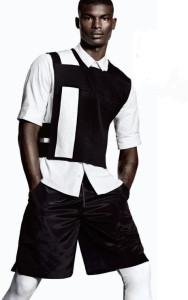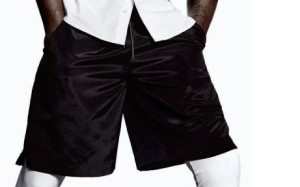PEAK PERFORMANCE: HOW FABRICS & TECHNICAL BRANDS ARE CHANGING THE GAME


In response to the male consumer’s growing interest in fashion, tech and health, retailers are shifting assortments. Performance fabrics are penetrating all categories from suiting to sportswear, from streetwear to designer collections. Here, we uncover how performance fabrics and technical brands are changing the menswear game…
Everyone is trying to get a piece of the performance pie. Even Google, which has been attempting to break into the fashion market for some time, is introducing a smart fabric. The New York Post recently reported that Google is developing fabric technology that “will make shirts, pants and other articles of clothing responsive to swipes and taps the same way touchscreens are.” Technological advances in fabrics and fibers are allowing more brands to offer functional fashion, and the trend is projected to continue.
Fashion Meets Function
It might sound obvious, but retailers agree that performance must incorporate fashion and function. “By fusing fabric technology from activewear with sportswear and clothing, the modern wardrobe now features a host of innovations including increased durability, stain resistance, breathability, anti-wrinkling and stretch,” explains Belinda Yu, Harry Rosen’s sportswear and outerwear buyer. “Performance wear extends across categories. In outerwear, we see stretch nylon down jackets and fabrics that keep your body at a consistent temperature as well as improvements in water resistance, memory yarns and ventilation. In suiting, we see performance fabrics that wear comfortably on an eight-hour flight, that stretch, can be folded and still look impeccably professional upon arrival.”
Durand Guion, VP and fashion director at Macy’s, says performance covers a broad range of classifications. “There are certainly customers who are well informed about wicking, UV protection and water resistance. There are also those who prefer to wear clothing with a nod to athletic design, whether on the course or at the clubhouse.”
At Saks Fifth Avenue, active is more important than performance. VP and fashion director Eric Jennings explains, “We’re interested in dressing the guy going to and from active sports. There’s a shift towards more casual, active-inspired sportswear in the market and we’re adjusting our assortments accordingly.” He says brands like Adidas/Porsche Design, J. Lindeberg Sport, EA7 and Orlebar Brown are currently selling.
The Impact of Active and Athleisure
Whether you love the word or hate it, there’s no denying that athleisure (athletic-inspired sportswear) is impacting menswear. As Yu believes, the athleisure trend spawned from the rise in true activewear. And now it’s acceptable to look like you’re going to the gym (even if you aren’t) as long as there’s some sort of fashion or modern element to your active look. She says that they’ve seen a spike in sales of athleisure items like joggers, hoodies and sweatshirts because consumers are looking for comfort. “And that’s where performance aspects like those found in DL Jeans’ three-way stretch technology come in. Or rainwear fabric and construction details that keep weather at bay while keeping him comfortable and stylish from Herno, Z Zegna and Arc’teryx Veilance.”
Jennings agrees. “Athleisure is taking up a bigger portion of our existing brands’ sportswear collections. Active sport, however, is a new zone and will be incremental business for us.”
Mr Porter recently launched a dedicated performancewear site in April aptly named Mr Porter Sport. Buying director for the luxury etailer, Toby Bateman, said in a statement, “We know that sport and fitness are integral to our customers’ interests and day-to-day lives, so we want to offer our global audience the best in men’s sports apparel. In keeping with our ethos of editing only the best brands within each category, we have chosen our sport brands based primarily on their technical performance properties, but also for their style.” The offering is broken down into nine sporting categories including running, cycling, tennis, golf, training, outdoor, swimming, sailing and overall fitness accessories from brands like Arc’teryx Veilance, APL, RLX, Nike and Patagonia.
At Harry Rosen, brands like Z Zegna are doing well because they’re fusing active ideas into the sportswear collection. Yu adds, “Canada’s own Arc’teryx Veilance has pushed aspects of its main line in a fashion-forward direction. Harry Rosen’s exclusive JP Tilford by Samuelsohn performance line was a game changer in improving functionality in suits.”
Athleisure is taking hold even at the moderate level. As David Mihalko, VP men’s at Belk observes, “The innovation that is coming out of the active market with technical fabrics and slimmer fits is definitely influencing sportswear trends from athleisure in young men’s/contemporary (with the dominant jogger silhouette) to performance as a new staple in tops and bottoms from all brands.”
Raising Awareness
Even with all this newness, the industry needs to educate consumers not only on what these performance features can do, but that they even exist in the first place. As NPD reported in March, consumer awareness on smart fabric technology is low, but the interest among consumers is there. “Smart fabrics are an important and innovative development for the fashion industry, but consumers don’t know enough about them to fully embrace them,” said Marshal Cohen, chief industry analyst for NPD. The report, which was based on a survey of 1,000 respondents from NPD’s online consumer panel of U.S. adults ages 18 or older, also noted that “less than half of consumers are aware of most smart fabrics, including those that have been available in the marketplace for several years. For some smart fabrics, including cooling and heat-modifying fabrics, interest is higher than awareness. When asked what types of apparel with smart fabric benefits would interest them most, consumers put workout clothing/activewear at the top of the list, driven by consumers age 18 to 34. Jeans and underwear follow activewear on the list, driven by consumers age 45 and older. One thing consistent among all age groups is the interest in cotton with smart fabric benefits.”
Belk is educating consumers about performance attributes through in-store signage, hang tags, and online videos. “Performance is driving positive comps in our menswear business,” explains Mihalko. “Our consumers have a love of the outdoors and active lifestyles. Features that are important to our consumer include
fabrics that keep you cool and dry during the summer months as well as lightweight fabrics that keep you warm in the winter months. Specific features that resonate are fabrics that wick moisture, are water-repellent or waterproof, that utilize body heat to insulate in our mild winters and fabrics that provide UV protection and cool the body during warmer months. Even in our traditional sportswear zones, wrinkle free properties are becoming more important for easy care options.” Brands driving the business in the active/outdoor space at Belk include Under Armour, Nike and Columbia; Polo, Vineyard Vines, Nautica and Calvin Klein Sportswear.
The Future of Performance
As new technology is developed almost daily, the opportunities for performance apparel are seemingly endless. Guion predicts we’ll be in an active/performance period for the foreseeable future. He elaborates, “The influence on menswear will continue as designers and brands evolve fabric details and silhouettes get a bit more relaxed. We’ll see more innovative and interesting uses of mesh for a textural element, graphic print and pattern details that add excitement and more refinement across the board. We may also see more strategic use of color to keep the customer interested beyond core shades like black, gray and navy.”








